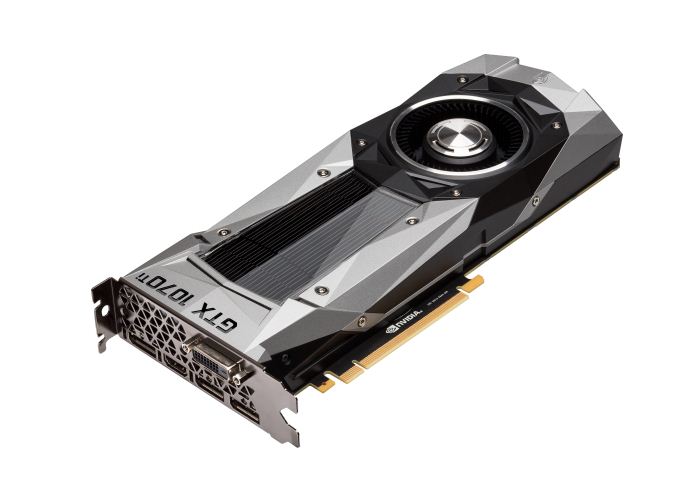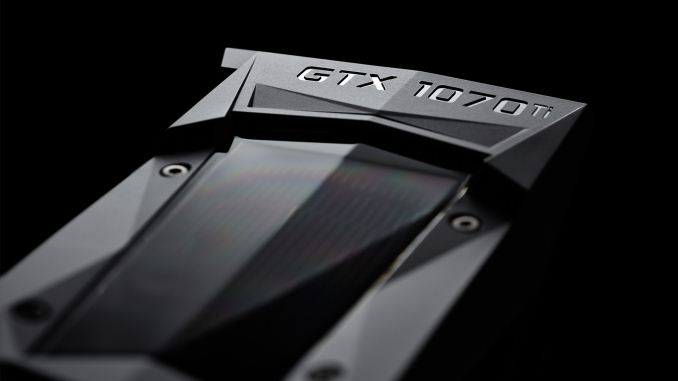The NVIDIA GeForce GTX 1070 Ti Founders Edition Review: GP104 Comes in Threes
by Nate Oh on November 2, 2017 9:00 AM EST- Posted in
- GPUs
- GeForce
- NVIDIA
- Pascal
- GTX 1070 Ti
Final Words
Bringing this review to a close, for better or worse, I think this is a launch that pulls no punches and offers no surprises. While AMD's Radeon RX Vega launch was not as impactful as many of us were hoping, it nonetheless had an impact. And that impact was against the GeForce GTX 1070, where the RX Vega 56 was fast enough to give AMD an edge on price/performance; at least when the card could be found in stock for near-MSRP prices.
Given that the RX Vega 56 placed between the GeForce GTX 1080 and GTX 1070, it was really up to NVIDIA as to if they wanted to respond, and to how. A third card in the enthusiast product stack is the straightforward solution to that problem, as it allows NVIDIA to reinforce their video card lineup against whatever foothold AMD can take. NVIDIA is playing a numbers game here – one that puts their new card just $50 below the GTX 1080 – but it's a careful calculus all the same. This is what a competitive market looks like: a little messier for sure, but also one where there are actions and reactions that give consumers more and better options.
Looking back at NVIDIA’s numbers, they seem more-or-less accurate. Based on the testing done for this review, our numbers have the GTX 1070 Ti around 13% faster than the GTX 1070, and about 8% slower than the GTX 1080. But this doesn’t support or reject the idea that the GTX 1080-1070 performance gap is capable of sustaining a new model there.
Comparing the GTX 1070 Ti head-to-head with AMD's Radeon RX Vega 56 is a little trickier, depending on the games. Generally speaking, the GTX 1070 Ti Founders Edition looks to be on the order of 5% faster than the reference RX Vega 56. The main question then returns to a matter of pricing. Just last week ahead of the GTX 1070 Ti announcement, the RX Vega 64 and RX Vega 56 were selling for $569 and $469 respectively. Since then, they've dropped by $50-$70, with retail prices running around $509 and $399 respectively, almost spot-on MSRP (if at last). Meanwhile as AMD's card prices continue to fluctuate, the new GTX 1070 Ti cards will have to remain within their $449 to $500 range, bounded by the $509 GTX 1080 and the $409 1070.
When graphics card prices change frequently, as they are now, numerous cards will drop in and out of the $250 - $550 area. Recommending the GTX 1070 Ti necessarily pigeonholes consumers to the $449 - $500 price bracket, which seems unwise when they still have the options of looking at cheaper GTX 1080 models, heavily overbuilt GTX 1070s, or even reference RX Vega 56s, all of which have been oscillating in price freely over the past couple of months. In real-world terms, as discussed earlier, today that might be the MSI GTX 1080 Armor 8G and EVGA GTX 1070 FTW Hybrid, both at the same price as a $499 GTX 1070 Ti. Or to put things another way, just last week the GeForce GTX 1070 Ti was poised to be RX Vega 56's direct competitor; this week its more of of a tantalizing spoiler for those who can reach a bit deeper into their wallets.
When it comes to comparing the GTX 1070 Ti to the RX Vega 56, it's ultimately a question of how competitive NVIDIA wishes to be and how quickly they want to react. If NVIDIA needs to completely cut-off the RX Vega 56, they can lower prices, otherwise if they just want to force AMD & vendors to bring their own prices back down to MSRP, then that job has just been done. Otherwise, looking briefly at the RX Vega 64 comparison, as you might expect from how it compares to the GTX 1080, the GTX 1070 Ti doesn't quite have the performance to outdo AMD's flagship air cooled card, leaving AMD in the lead by 5%. This means that the GTX 1070 Ti isn't the RX Vega 64's direct competitor either, however it's a potential spoiler by offering 90-95% of the gaming performance for 88% of the cost (not to mention the superior power efficiency).
Meanwhile, speaking very strictly here just within NVIDA's product stack, at today's $409/$449/$509 prices, the GTX 1070 Ti is, if only slightly, the best bargain of the three cards: it's 13% faster than the GTX 1070 for an 10% price increase, and similarly, the last 8% of the performance of the GTX 1080 comes with a 13% price premium. Otherwise all three cards are very similar, scaling in performance, price, and power consumption as you traverse the narrow $100 range. NVIDIA is pitching the GeForce GTX 1070 Ti as an upgrade for the practically legendary GTX 970, however since it launched at only $329, the GTX 970 was never this expensive. Arguably this is more of a late upgrade option for the GTX 980, but at this point I'm splitting hairs. If you are upgrading from an older NVIDIA card, you have a clear price/performance spectrum to pick from.
Otherwise, as custom GTX 1070 Ti cards hit the market over the next few weeks and settle down, it will become clearer what options they bring and how they fit into the market. Looking at our results, a factory-overclocked custom GTX 1070 Ti could easily hit GTX 1080 levels, but is not likely to be an option for precisely that reason.
Returning to the GTX 1070 Ti Founders Edition, it is a solid card with the GTX 1080 Founders Edition's vapor chamber cooler and reference 5+1 power phase PCB, all at a static $449 and reasonable power consumption. But ultimately it is a reference card with performance in between the GTX 1070 and GTX 1080, with a price to match. Given that GTX 1080 and 1070 models have been in that space for some time, that price point may be better some days and not on others for what you need. This isn't a card that is meant to drastically alter the enthusiast video card market in the last months of the year – which is to say that it doesn't do much to alter the balance between NVIDIA and AMD – but rather it's a card that is designed to offer a proportional option between the GTX 1080 and GTX 1070.












78 Comments
View All Comments
Destoya - Thursday, November 2, 2017 - link
I feel like you're ignoring cards like the 1050ti/1050 in order to better match your narrative. Both of those require no power connectors (75W TDP) and will reach 1080p60 easily for modern AAA games and 144 FPS on esports titles. Yes, both companies are making power hungry monster cards to satisfy high-end demand that get a lot of headlines, but the chip designs scale down incredibly well. Performance for low/mid-end systems has never been as good as it is now.The_Assimilator - Friday, November 3, 2017 - link
Yes yes, everybody should still be using teletype terminals and typewriters. Or even better, go back to scratching lines into cave walls with rocks, because that uses no power and creates no heat.Lord of the Bored - Friday, November 3, 2017 - link
Actually, it does create heat. Thermodynamics is a harsh mistress.catavalon21 - Thursday, January 10, 2019 - link
+1sonny73n - Friday, November 3, 2017 - link
Graphic and resolution mean the world to them because they have no life.theuglyman0war - Saturday, November 4, 2017 - link
I thought it was because God gave us two eyes that can see? ( the same reason I get my prescription glasses updated every year. Fidelity. )Is Lo Fi hip again?
Ranger1065 - Friday, November 3, 2017 - link
You should be removed ASAP dear Ciccio.TheJian - Thursday, November 2, 2017 - link
Bought mine at $499 (EVGA FTW2). Don't feel gouged at all. If it's gouging, they'd still be on the shelf. I'm guessing they'll be out of stock shortly. If they priced like you want, they'd have quarterly reports like AMD.. ROFL. That should not be the goal for NV, but rather to price as high as the market will accept...PERIOD. It is actually their JOB to do this.Sounds like you need to upgrade your job so you can afford better toys ;) AMD has lost $8B in the last 2 decades and looks like they only made money for a single quarter this time. They are predicting a down Q yet again (how can you have a bad xmas Q?) and just after all these launches. YOU ARE PRICING YOUR STUFF TOO LOW AMD!
bill.rookard - Thursday, November 2, 2017 - link
Well, that's not entirely accurate, AMD has had some nominally profitable quarters before this - not to the level of Intel for sure, but saying they've lost money every single quarter in the past 20 years is patently untrue. There were many times 'in the past two decades' when they were actually eating Intel's lunch, so enough of the hyperbole.Yes, they've not had an easy time since then, and have been in the dumps especially with their previous generation designs which, well, sucked. (caveat, the 8 core 8000 series actually did well on video encoding but that wasn't nearly enough)
As for pricing stuff too low? They HAVE to right now. Their issue is one of market share, and with their previous generation u-arch it couldn't remotely compete with Intel, and that pitiful share is the result. Now that they have a u-arch which is close to parity from power and performance, just wait to see what happens in the notebook space where the Intel IGP is pitifully bad compared to the Mobile Vega. Besides - the main 'desktop' space is, while not dying, it is without a doubt somewhat stagnant as most people have a laptop which is powerful enough to get stuff done, while being portable.
That is the larger market, and one that the Ryzen APU's will have a much better chance at picking up share in.
webdoctors - Thursday, November 2, 2017 - link
You;re right, there was I guess maybe 40% quarters were profitable last 10 years:https://ycharts.com/companies/AMD/eps